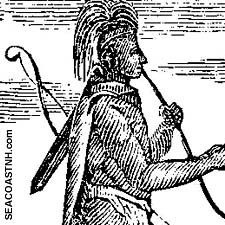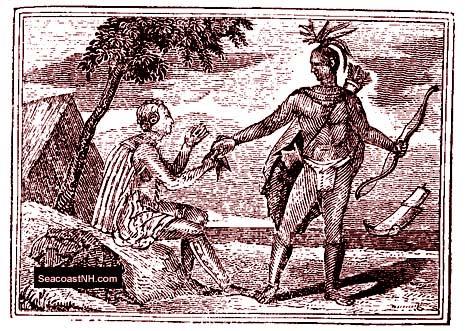|
FRESH STUFF DAILY |
|
|
||
|
|
||
|
|
||
|
SEE ALL SIGNED BOOKS by J. Dennis Robinson click here |
||
Page 1 of 2
With few facts to flesh out their story, Native Americans have become largely invisible in early NH history. They appear largely in stories about Indian raids on white settlements at the turn of the 18th century. But a much deeper and detailed study is needed.
EDITOR'S NOTE: This essay is adapted from a history of Portsmouth and Strawbery Banke now in development. SEE ALSO: Passaconaway Most accounts of early Portsmouth scarcely mention its original settlers at all. Thousands of years of Native American occupation are reduced to a sentence or two. Often the only references are to Indian raids on white settlers during King Phillips war late in the 1600s when French soldiers fighting the British helped stir up Native rebellion. With almost no documentation of Indian life here before English occupation, we have to look for evidence elsewhere. When Captain John Walker explored Maine’s Penobscot River in 1579, he reported seeing Native Americans there. But the first detailed eye witness account from an Englishman first visiting this region comes from Bartholomew Gosnold who examined the coast from Maine to Massachusetts in 1602. The meeting did not go as you might expect.
Spotting eight men in a "Biscay shallop with sail and oars" probably near what is now Cape Ann, Gosnold at first thought they were European fishermen in distress. It was only when the party of Indians came aboard ship that he realized who they were. One man in the group of Natives wore "Christian" clothing including a black waistcoat, breeches, shoes, stockings and a hat with a band. The rest were naked except for short pants made from seal skin and deerskins thrown loosely about their shoulders. The Indians gave a lengthy speech using some "Christian words" and drew Gosnold a map of the area using a piece of chalk. In memory of this initial close encounter with an obviously intelligent and adaptable new race, Gosnold named the location of the meeting "Savage Rock". Native Americans, despite their obviously sophisticated culture would remain "savages" and "heathens" to many New England historians through the next three centuries. Their story remains largely untold to this day. Martin Pring, who had traveled with Gosnold, was the first known European explorer to document a trip 10 or 12 miles up the Piscataqua River in 1603. "In all these places," Pring reported, "we found no people, but signes of fires where they had been." CONTINUE INDIAN ESSAY
Please visit these SeacoastNH.com ad partners.
News about Portsmouth from Fosters.com |
| Friday, April 26, 2024 |


|
Copyright ® 1996-2020 SeacoastNH.com. All rights reserved. Privacy Statement
Site maintained by ad-cetera graphics

 Smuttynose Murders
Smuttynose Murders




















